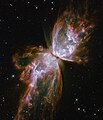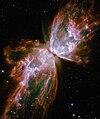English: Butterfly Emerges from Stellar Demise in Planetary Nebula NGC 6302
The Wide Field Camera 3 (WFC3), a new camera aboard NASA's Hubble Space Telescope, snapped this image of the planetary nebula, catalogued as NGC 6302, but more popularly called the Bug Nebula or the Butterfly Nebula. WFC3 was installed by NASA astronauts in May 2009, during the servicing mission to upgrade and repair the 19-year-old Hubble telescope.
NGC 6302 lies within our Milky Way galaxy, roughly 3,800 light-years away in the constellation Scorpius. The glowing gas is the star's outer layers, expelled over about 2,200 years. The "butterfly" stretches for more than two light-years, which is about half the distance from the Sun to the nearest star, Alpha Centauri.
The central star itself cannot be seen, because it is hidden within a doughnut-shaped ring of dust, which appears as a dark band pinching the nebula in the center. The thick dust belt constricts the star's outflow, creating the classic "bipolar" or hourglass shape displayed by some planetary nebulae.
The star's surface temperature is estimated to be about 400,000 degrees Fahrenheit, making it one of the hottest known stars in our galaxy. Spectroscopic observations made with ground-based telescopes show that the gas is roughly 36,000 degrees Fahrenheit, which is unusually hot compared to a typical planetary nebula.
The WFC3 image reveals a complex history of ejections from the star. The star first evolved into a huge red-giant star, with a diameter of about 1,000 times that of our Sun. It then lost its extended outer layers. Some of this gas was cast off from its equator at a relatively slow speed, perhaps as low as 20,000 miles an hour, creating the doughnut-shaped ring. Other gas was ejected perpendicular to the ring at higher speeds, producing the elongated "wings" of the butterfly-shaped structure. Later, as the central star heated up, a much faster stellar wind, a stream of charged particles traveling at more than 2 million miles an hour, plowed through the existing wing-shaped structure, further modifying its shape.
The image also shows numerous finger-like projections pointing back to the star, which may mark denser blobs in the outflow that have resisted the pressure from the stellar wind.
The nebula's reddish outer edges are largely due to light emitted by nitrogen, which marks the coolest gas visible in the picture. WFC3 is equipped with a wide variety of filters that isolate light emitted by various chemical elements, allowing astronomers to infer properties of the nebular gas, such as its temperature, density, and composition.
The white-colored regions are areas where light is emitted by sulfur. These are regions where fast-moving gas overtakes and collides with slow-moving gas that left the star at an earlier time, producing shock waves in the gas (the bright white edges on the sides facing the central star). The white blob with the crisp edge at upper right is an example of one of those shock waves.
NGC 6302 was imaged on July 27, 2009, with Hubble's Wide Field Camera 3 in ultraviolet and visible light. Filters that isolate emissions from oxygen, helium, hydrogen, nitrogen, and sulfur from the planetary nebula were used to create this composite image.
These Hubble observations of the planetary nebula NGC 6302 are part of the Hubble Servicing Mission 4 Early Release Observations.
العربية: فراشةٌ تنبعتُ من موت نجمٍ في السديم المُسمَّى NGC 6302
التُقطت هذه الصُورة بِواسطة الكاميرا واسعة المجال 3 (WFC3)، وهي كاميرا جديدة تابعة لِوكالة ناسا محمولة على متن مقراب هابل الفضائي. يُفهرس هذا النجم تحت مُسمَّى NGC 6302، على أنَّهُ يشتهر أكثر باسم سديم الحشرة أو سديم الفراشة. أدرج رُوَّادُ الفضاء العاملين مع ناسا هذه الكاميرا خِلال شهر أيَّار (مايو) سنة 2009، أثناء مُهمتهم القاضية بِإصلاح وتطوير مقراب هابل البالغ من العُمر 19 سنة.
يقعُ سديمُ الفراشة في مجرَّة درب التبَّانة، على بُعد 3,800 سنة ضوئيَّة تقريبًا في كوكبة العقرب. الغازُ الَّلمَّاع هو الطبقات الخارجيَّة من النجم البائد، الذي انطفأ مُنذ ما يزيد عن 2,200 سنة. تمتدُّ «الفراشة» لِما يزيدُ عن سنتين ضوئيتين، وهي مسافة تُساوي حوالي نصف المسافة المُمتدَّة بين الشمس وأقربُ نجمٍ إليها، وهو نجمُ رجل القنطور.
النجم المركزي نفسه لا يُمكن رُؤيته، كونهُ واقع في قلب حلقةٍ من الغُبار شكلها أشبه بِشكل كعكة الدونط، التي تبدو لِلناظر وكأنها شريطٌ قاتم يعصر السديم في وسطه. يتكوَّن حزامُ الغُبار السميك من المواد التي تدفَّقت من النجم، ممَّا يجعل شكله «ثُنائي القُطب» أو أشبه بِشكل الساعة الرمليَّة، وهو الشكل التقليدي الذي تظهر عليه بعض السدائم.
تُقدَر درجة حرارة سطح النجم بِحوالي 400,000 درجة على مقياس فهرنهايت، ممَّا يجعله أحد أحر النُجوم في مجرَّتنا. تُظهرُ المُلاحظات والمُراقبات الطيفيَّة التي أُجريت باستخدام مقرابات أرضيَّة أنَّ درجة حرارة الغاز تصلُ إلى حوالي 36,000 درجة على مقياس فهرنهايت، وهي درجةٌ مُرتفعة لِلغاية إن قورنت بِغيرها من درجات حرارة السدائم النمطيَّة.
تكشفُ صُورة الكاميرا سالفة الذكر عن تاريخٍ مُعقدٍ لِلمواد المُلفظة خارج هذا النجم. بدايةً تطوَّر هذا النجم إلى عملاقٍ أحمرٍ، بِقطرٍ يفوقُ قُطر الشمس بِحوالي 1,000 مرَّة. ثُمَّ خسر طبقاته الخارجيَّة المُمتدَّة. لُفظ بعضُ هذا الغاز خارج خط استوائه بسُرعةٍ مُنخفضةٍ نسبيًّا، يُحتمل أنها بلغت 20,000 ميلٍ في السَّاعة، ممَّا تسبب بِظُهور الحلقة الشبيهة بِكعكة الدونط. لُفظت بعضُ الغازات الأُخرى بِشكلٍ مُتعامدٍ مع الحلقة بِسُرعةٍ أكبر، ممَّا نجم عنه ظُهور «الجناحان» الشبيهة بِجناحيّ الفراشة التي تُميّزُ هذا السديم. في وقتٍ لاحق، ومع ازدياد حماوة النجم المركزي، تدفَّقت رياحٌ نجميَّة بِسُرعةٍ قُصوى، وهي عبارة عن تيَّارٌ من الجُزيئات المشحونة المُنطلقة بِسُرعةٍ تفوق مليونيّ ميل في السَّاعة، تدفَّقت عبر البُنية الشبيهة، ممَّا أدَّى إلى تعديل شكلها أكثر.
تُظهرُ الصُورة أيضًا عدَّة إنبعاثات إصبعيَّة الشكَّل تُشيرُ نحو النجم، ويُحتمل بِأنَّ هذه نقاطٌ أسمك من المواد المُتدفقة تمكَّنت من الصُمود بِوجه الرياح النجميَّة العاتية والضغط المُرتفع المُتولِّد عنها.
حواف السديم الخارجيَّة المُحمرَّة تظهرُ على هذا الشكل بِسبب الضوء المُنبعث من النيتروجين، وهو أبرد أنواع الغازات التي يُمكن رؤيتها في الصُورة. الكاميرا مُجهَّزة بِطائفةٍ واسعة من المُصفيات (الفلاتر) التي تعزل الانبعاثات الضوئيَّة بِواسطة عناصر كيميائيَّة مُختلفة، ممَّا يسمح لِرُوَّاد الفضاء استنتاج خصائص الغازات السديميَّة، مثل حرارتها، وكثافتها، وتركيبتها.
المناطق البيضاء هي الأماكن التي ينبعث منها الضوء بِواسطة الكبريت. في هذه المناطق تُدركُ الغازات السريعة نظيرتها البطيئة التي لُفظت خارج النجم قبلًا وتحتك معها، ممَّا يتسبب بِموجاتٍ صدميَّة في الغاز (الأطراف البيضاء اللامعة على الجانبين المُواجهة لِلنجم المركزي). النُقطة البيضاء الواقعة على الطرف المُتموِّج في أعلى اليمين هي إحدى الأمثلة عن مثل هذه الموجات الصدميَّة.
صُوَِّر هذا السديم بدايةً يوم 27 تمُّوز (يوليو) 2009، باستخدام كاميرا هابل واسعة المجال 3 بِالأشعَّة فوق البنفسجيَّة وبِالضوء الطبيعي. استُخدمت مُصفيات تعزل الانبعاثات الصادرة عن غازات الأكسجين، والهيليوم، والهيدروجين، والنيتروجين، والكبريت الكامنة في هذا السديم لِإنتاج هذه الصُورة المُركبة.
تُشكِّلُ مُراقبات ودراسات هابل هذه جُزءًا من مُهمَّة المرصد الإصلاحيَّة الرابعة.




